When it comes to Labradors and cold weather, there’s a lot to consider. These adorable and friendly dogs are known for their thick double coat and adaptability, making them generally well-suited for chilly temperatures. However, it’s important to understand their limits and take precautions to ensure their safety and comfort.
Labradors can handle colder conditions better than some other breeds, thanks to their water-resistant fur and insulating coat. But just like us, they have their thresholds too. It’s important to be aware of how long they can stay outside in the cold and make sure they are adequately protected.
In this article, we will dive into the details of Labradors in the cold and discuss factors such as the safe temperature range for dogs, their origins in cold climates, winter activities, and how to keep them warm and comfortable. So, let’s bundle up and get started!
Click Here to Jump to a Section
Key Takeaways:
- Labradors have a thick double coat and water-resistant fur, making them well-suited for cold weather.
- The safe temperature for dogs can vary based on factors such as breed, size, weight, age, health, and coat.
- Labradors were originally bred in Newfoundland and are well-adapted to cold and wet environments.
- Factors to consider when walking Labradors in the cold include the type of activity, environmental conditions, and the presence of salt on sidewalks.
- Signs of cold in dogs include shivering, lifting paws, trembling, and changes in body language.
How Cold is Too Cold for Dogs?
When it comes to determining how cold is too cold for dogs, there are several factors to consider. The safe temperature for dogs can vary based on their breed, size, weight, age, health, and coat. As responsible pet owners, it’s crucial to understand these variables and take the necessary precautions to keep our furry friends safe and comfortable in chilly temperatures.
As a general guideline, it is recommended to start monitoring a dog’s comfort levels when temperatures drop below 45°F (7°C). At this point, small breeds, thin-coated dogs, older dogs, or dogs with underlying health issues may begin to feel the effects of the cold more intensely. It’s important to limit their outdoor time and ensure they have access to warm shelter.
Below 32°F (0°C), the risk of hypothermia and frostbite significantly increases. This is especially true for dogs with shorter fur or exposed skin. Close monitoring is crucial, and it’s best to keep outdoor activities brief and provide extra layers of warmth, such as dog jackets or sweaters.
When temperatures drop below 20°F (-6°C), the risk of cold-related conditions becomes even more severe. Hypothermia and frostbite can set in quickly, leading to serious health complications. At this point, it’s important to prioritize your dog’s safety and minimize outdoor exposure as much as possible.
“The safe temperature for dogs can vary depending on factors such as breed, size, weight, age, health, and coat.”
A dog’s tolerance to the cold can also depend on their individual adaptation to the environment. Some breeds, such as Huskies and Malamutes, have been bred for cold weather conditions and may have a higher tolerance for lower temperatures. On the other hand, certain breeds, like Chihuahuas and Greyhounds, are more susceptible to the cold due to their smaller size, thin coats, and lower body fat.
It’s important to pay attention to your dog’s body language and behavior when exposed to colder temperatures. Signs of discomfort or distress, such as shivering, lifting paws off the ground, or seeking warmth, indicate that it’s time to bring them indoors and provide them with a warm and cozy space.
Remember, as pet owners, it’s our responsibility to prioritize the well-being of our furry companions. By being aware of the safe temperature ranges for dogs and taking the necessary precautions, we can ensure their safety and comfort in cold weather conditions.
Labradors and Cold Weather: Origins and Adaptability
Labradors have a fascinating history intertwined with cold weather and their adaptability to various environments. These lovable canines were originally bred in Newfoundland, a region known for its icy waters and harsh winters. Their origins as working dogs involved retrieving fish and assisting in hunting expeditions in challenging conditions.
Their unique features and characteristics enable them to thrive in cold climates. One of their standout attributes is their thick double coat, which provides insulation and protection against frigid temperatures. This dense coat helps to keep them warm and shielded from the elements. Additionally, Labradors have water-resistant fur, which helped them with their original tasks of retrieving fish from icy waters.
Another aspect that contributes to their adaptability in cold weather is their webbed feet. This distinctive trait allows them to navigate through wet and snowy terrain with ease. The webbing enhances their ability to walk on various surfaces, providing stability and preventing slips and falls.
The Love for Cold Activities
Labradors’ history and genetic makeup have instilled in them an affinity for chilly activities. They enjoy romping in the snow, exploring wintry landscapes, and playing outdoors in cool weather. Their enthusiasm is contagious, and their energy levels can be boundless, especially when engaging in outdoor winter activities.
However, while Labradors have a natural inclination towards the cold, it is crucial to monitor their comfort and well-being. Cold stress or exposure to extremely low temperatures for extended periods can have adverse effects on their health. It is important to prioritize their safety and take appropriate measures to ensure their warmth and protection.
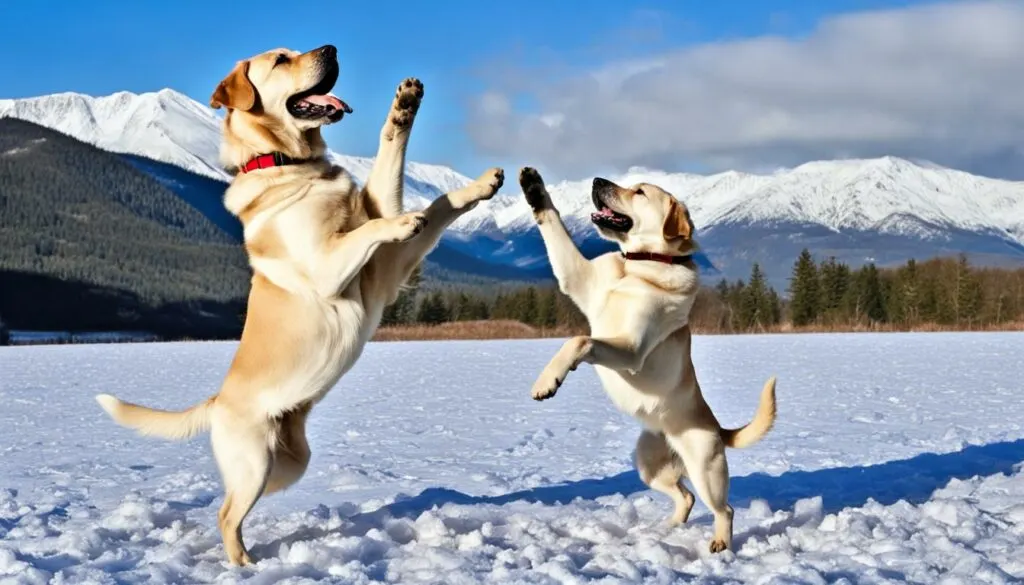
Labradors truly exemplify the remarkable adaptability of certain breeds to cold climates. Their origins, thick double coat, webbed feet, and love for all things cold make them an ideal companion for individuals living in regions with challenging winter conditions. By understanding their unique characteristics and providing appropriate care, Labradors can continue to thrive and bring joy to their owners in even the coldest of climates.
Factors to Consider for Walking Labradors in the Cold
When walking labradors in the cold, there are several important factors to keep in mind to ensure their safety and well-being. Here are some key considerations:
- Type of Activity: The intensity and duration of the activity should be adjusted according to the temperature. In very cold weather, it’s advisable to engage in shorter walks or opt for indoor exercises to minimize exposure to the cold.
- Environmental Conditions: Pay attention to the wetness and wind factor as they can significantly affect the dog’s comfort. A damp, chilly breeze can make the temperature feel much colder than it actually is.
- Presence of Salt on Sidewalks: In colder regions, sidewalks are often treated with salt or de-icing chemicals. These substances can be harmful to a dog’s paws. To protect their feet, consider using booties or rinsing their paws with warm water after walks.
Labradors can generate body heat through exercise, which can help keep them warm even in the cold weather. However, it’s important to monitor their behavior closely for signs of discomfort or cold stress, such as shivering or lifting their paws off the ground. If these signs become evident, it is advisable to bring them indoors and warm them up.
To provide added warmth and comfort, you may consider investing in protective gear such as water-repelling coats and booties for your labrador. These can help shield them from the cold and wetness, providing an extra layer of insulation. Additionally, make sure the gear fits properly and introduce it gradually to ensure your dog’s comfort.
Signs of Cold in Dogs: How to Tell If Your Labrador is Cold
As responsible owners, it’s crucial to understand the signs of cold in dogs, especially when it comes to our beloved Labrador Retrievers. These intelligent and adaptable beings may display various indications that they require warmth and shelter.
One of the most common signs of cold in dogs is shivering. When your Labrador starts trembling or their body shakes involuntarily, it’s a clear signal that they are feeling the chill. Additionally, pay attention to any changes in their body language. They may hunch their back, tuck their tail between their legs, or seek shelter, indicating their discomfort in the cold.
Another telltale sign is when your Labrador lifts their paws while walking. This behavior may be an attempt to avoid prolonged contact with the cold ground, which can cause discomfort and even frostbite. Additionally, if you notice your Labrador trembling, it’s a clear indication that they are trying to generate heat to combat the cold.
If your Labrador displays any of these signs, it’s essential to promptly address their needs. Bring them indoors and provide them with a warm and cozy environment. Remember, Labrador Retrievers are social animals and may seek comfort by snuggling with their owners or seeking a comfortable spot near a heat source.
Tip: When your Labrador shows signs of cold, avoid rubbing their body vigorously. Instead, wrap them in a warm blanket or coat, allowing their body heat to regulate naturally.
Regularly monitoring your Labrador’s body language and comfort in cold weather is key to ensuring their well-being and preventing potential risks, such as hypothermia. By being attentive to their needs and providing the necessary warmth, you can keep your furry companion safe and protected during the colder months.
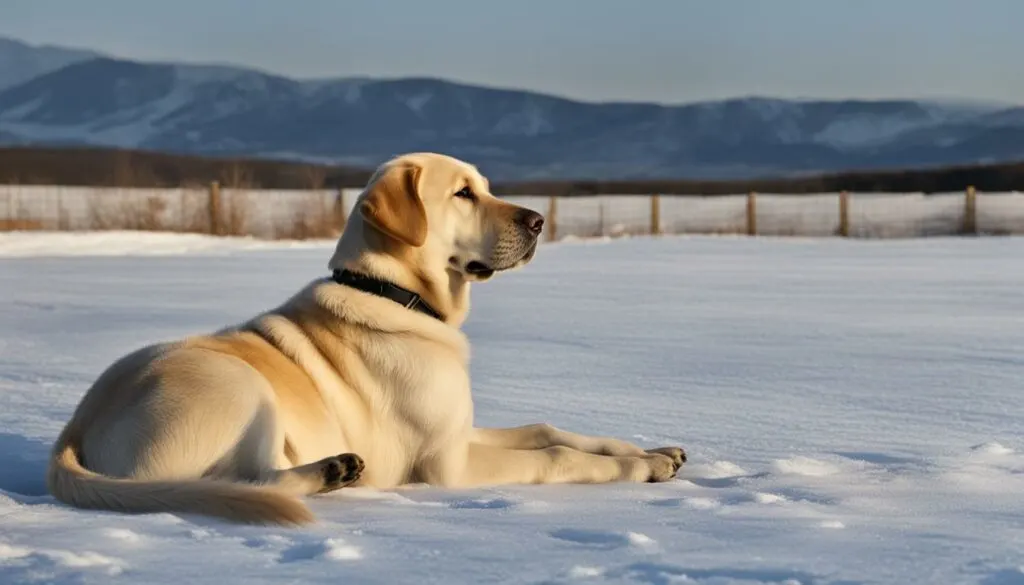
Labrador Retrievers and Snow: Winter Activities and Safety
Labradors are known to have a blast playing in the snow. It’s a joy to watch them frolic and explore in this wintry wonderland. However, as responsible pet owners, it’s essential to take certain precautions to ensure their safety in snowy conditions.
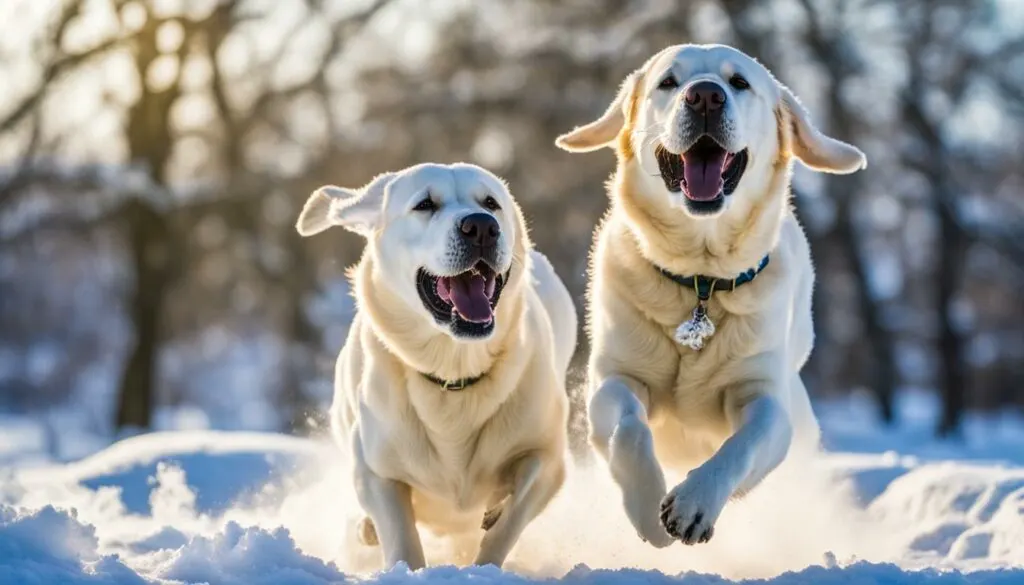
Why is it important to keep Labradors dry?
After playing in the snow, Labradors might get wet, which can decrease their ability to insulate body heat. It’s crucial to dry them off thoroughly after their snowy adventures to prevent them from getting too cold.
Signs of discomfort in snowy conditions
Labradors are usually resilient in cold weather, but they can experience discomfort in extreme conditions or due to prolonged exposure. Keep a watchful eye for signs of discomfort, such as lifting their paws, trembling, or seeking shelter. These signs indicate that your canine companion might need a break from the cold.
“Observing your Labrador’s behavior in the snow is key. They might give you cues that they’re feeling uncomfortable. Paying attention to their body language and taking the necessary steps to keep them warm and safe is vital.” – Dr. Lisa Johnson, Canine Veterinarian
Providing warm shelter
If your Labrador shows signs of discomfort in the snow, it’s essential to provide them with a warm shelter to retreat to. This could be a cozy spot indoors or a well-insulated outdoor dog house designed to protect them from wind and moisture.
Remember, each Labrador is unique, and their tolerance to cold weather may vary. Be attentive to their needs and adjust their outdoor activities accordingly to ensure their safety and well-being during winter adventures.
Labrador Winter Gear: Coats and Booties
In colder climates, investing in proper winter gear for your Labrador can help protect them from the harsh elements. Labrador winter gear includes water-repelling coats and booties that provide insulation and keep their paws safe from salt and ice.
When choosing winter coats for Labradors, we recommend considering brands like UpCountry, which offer a variety of stylish and functional options. These coats are designed to repel water and provide an extra layer of warmth, keeping your Labrador comfortable during winter walks and outdoor activities.
Booties are another essential piece of Labrador winter gear. Brands like Pawz offer booties that are specifically designed to fit Labrador paws comfortably. These booties provide protection from salt and ice, preventing any potential injuries or discomfort that can arise from contact with these substances.
It’s important to properly fit the winter gear to ensure your Labrador’s comfort. Gradually introduce the gear to your dog, allowing them to adjust to wearing coats and booties before taking them out in cold weather. Supervise them closely during the initial uses to ensure a proper fit and prevent any discomfort.
Remember, Labrador winter gear, such as coats and booties, not only provides protection but also adds a touch of style to your furry friend’s winter ensemble.
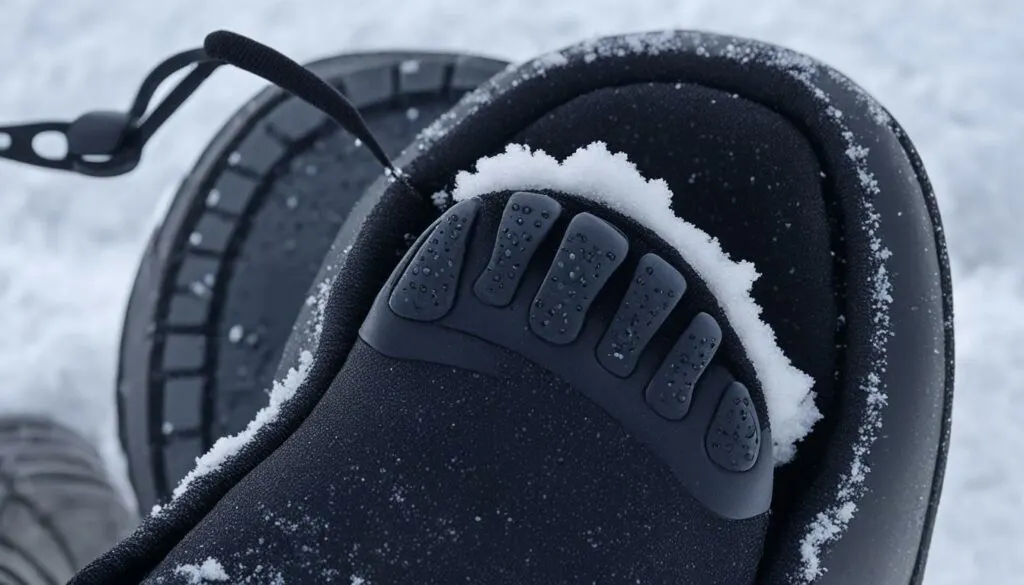
Labrador Retriever and Cold Weather: Health Considerations
When it comes to Labrador Retrievers and cold weather, it’s important to be aware of the potential health risks that can arise. Cold weather can worsen certain preexisting health conditions in Labradors, such as joint problems and arthritis.
One of the key ways to protect your Labrador’s health in cold weather is by providing them with proper warmth. Ensure they have access to a warm and comfortable shelter where they can seek refuge from freezing temperatures.
Comfortable bedding is also essential to keep your Labrador cozy and provide insulation from the cold ground. Opt for soft and warm bedding materials to help regulate their body temperature.
In addition to warmth, monitoring your Labrador’s exposure to freezing temperatures is crucial. Limit their time outdoors in extremely cold weather and pay attention to any signs of discomfort or distress.
Regular veterinary check-ups are important to address any existing health concerns and ensure that your Labrador is in optimal health to withstand the challenges of cold weather. Your veterinarian can provide guidance on additional measures to protect your Labrador’s well-being.
Remember, the health of your Labrador should always be a top priority, especially in cold weather conditions. By providing warmth, comfortable bedding, limiting exposure to freezing temperatures, and regular veterinary care, you can help keep your Labrador safe and healthy throughout the winter months.
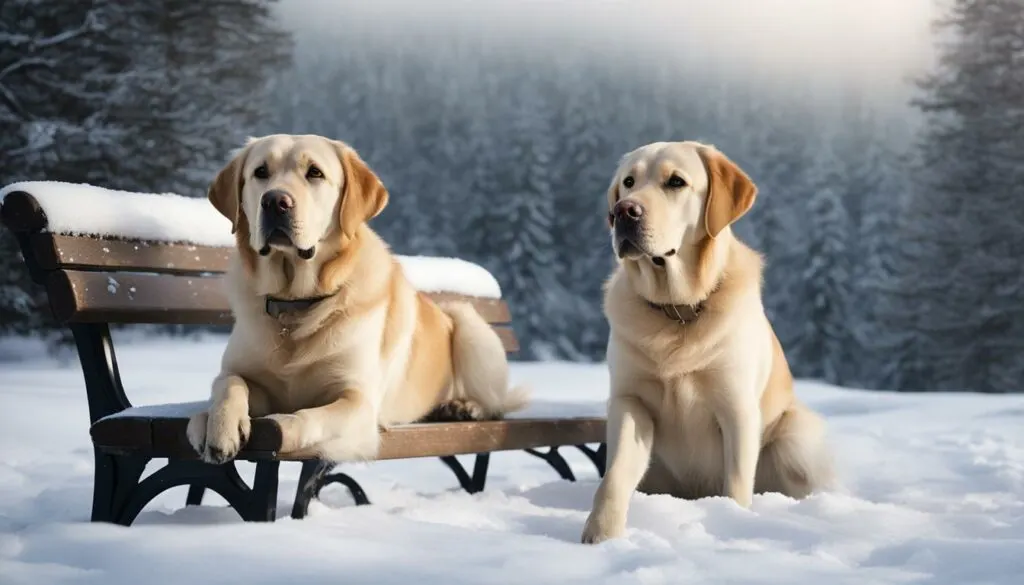
Grooming Labradors in Winter: Coat Maintenance and Bathing
Proper grooming is essential for Labradors in winter. By taking care of their coat, we can ensure that they stay warm, comfortable, and protected in cold weather. Here are some important tips for grooming Labradors during the winter months:
Regular Brushing
Regular brushing is crucial for maintaining a healthy coat in Labradors during winter. It helps remove dead hair, tangles, and matting, allowing the natural oils to distribute evenly. Use a slicker brush or a grooming mitt to gently brush their double coat, starting from the top and working your way down to the skin.
Limit Bathing
Bathing should be limited during winter to prevent drying out the skin. Excessive bathing can strip away the natural oils that keep the coat insulated. However, if your Labrador gets excessively dirty or smelly, use a gentle, moisturizing shampoo and ensure thorough rinsing to remove all soap residue. Afterward, dry your dog completely to avoid any lingering moisture.
Tip: Avoid bathing your Labrador outdoors during cold weather. Instead, choose a warm and well-ventilated space indoors to ensure their comfort.
Maintain Coat Length
Trimming your Labrador’s coat during winter is not recommended, as their long, dense fur provides insulation from the cold. However, it’s important to keep their fur neat and free from mats to avoid trapping moisture against their skin. Use scissors or a de-matting tool to carefully remove any tangles or mats.
Foot Care
In winter, Labradors can be exposed to ice, slush, and salt on the ground. Protect their paws by using a paw balm or applying petroleum jelly to keep them moisturized and prevent painful cracking. Regularly trim the hair between their paw pads to minimize ice and snow accumulation. Consider using booties to provide additional warmth and protection.
Quote: “Proper grooming not only keeps your Labrador looking their best, but it also plays a crucial role in maintaining their coat’s insulation and protection during the winter months.” – Labrador Grooming Expert
By following these grooming tips, you will ensure that your Labrador’s coat remains healthy and resilient throughout the winter season. Remember, a well-groomed coat is essential for their overall well-being in colder weather. Stay tuned for the next section where we will discuss shelter and comfort for Labradors in cold weather.
Shelter and Comfort for Labradors in Cold Weather
When it comes to keeping our beloved Labradors warm in winter, providing them with proper shelter is essential. Whether they spend most of their time outdoors or are primarily indoor dogs, ensuring their comfort in cold weather is our responsibility.
Outdoor Shelter
If your Labrador spends a significant amount of time outside, it’s crucial to provide them with a warm and safe shelter. Consider investing in an insulated dog house that offers protection from wind and moisture. This will help keep them cozy and shielded from the harsh elements. Remember, their shelter should have a raised floor to prevent direct contact with the cold ground and a sturdy roof to keep out rain and snow.
Creating a warm and comfortable bedding area within the dog house is also important. You can use blankets, straw, or specifically designed dog bedding to provide insulation and extra warmth. It’s essential to regularly check and replace bedding as needed to maintain cleanliness and freshness.
Indoor Comfort
Even if your Labrador primarily stays indoors, they still need a warm sleeping spot away from drafts. Choose a cozy corner or provide them with a comfortable dog bed that is well-insulated and away from windows or doors. This will ensure they stay warm and snug during chilly nights. Additionally, make sure their bed is in a quiet and peaceful area, away from any drafts or cold air vents.
Remember, Labradors are sociable dogs and love being part of the family. Ensuring their comfort indoors means they can still be part of our daily activities while staying warm. It’s important to create a designated area for them where they can relax and feel safe.
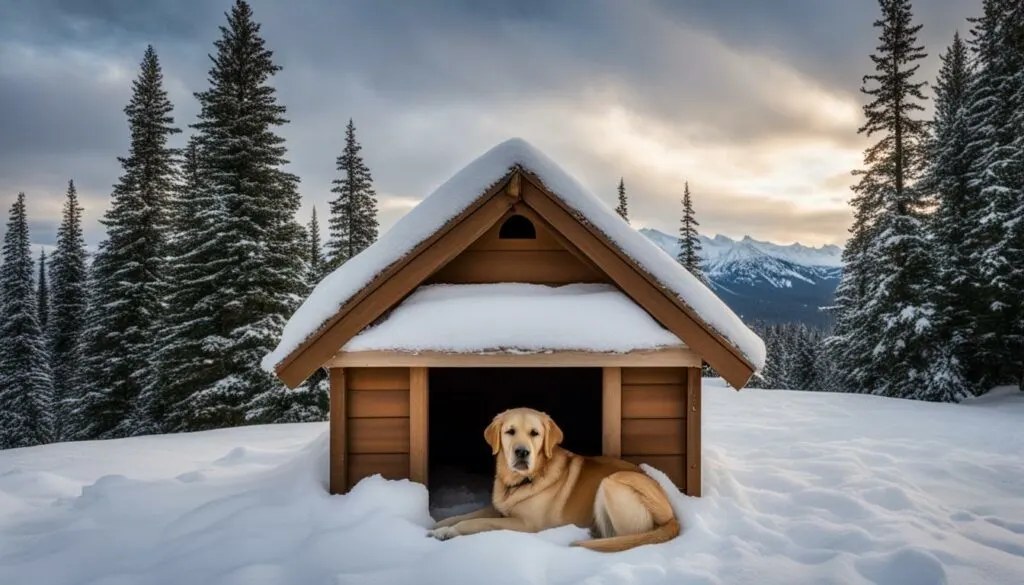
“In cold weather, it’s our responsibility to provide Labradors with warm shelter and ensure their comfort. Whether they spend time outdoors or indoors, a cozy and safe environment is crucial for their well-being.”
By considering their needs and providing the right shelter and comfortable sleeping areas, we can ensure our Labradors stay warm and protected throughout the winter season. Let’s prioritize their comfort and make their winter experience enjoyable and safe.
Training and Adjusting Labradors to Cold Conditions
When it comes to training labradors for cold weather, a gradual approach is key to ensure their comfort and adaptation. Gradually exposing them to colder temperatures will help them adjust and build tolerance to the cold. It’s essential to create positive experiences during this process, such as engaging in fun activities in the snow or providing treats and praise when they are outside in the cold.
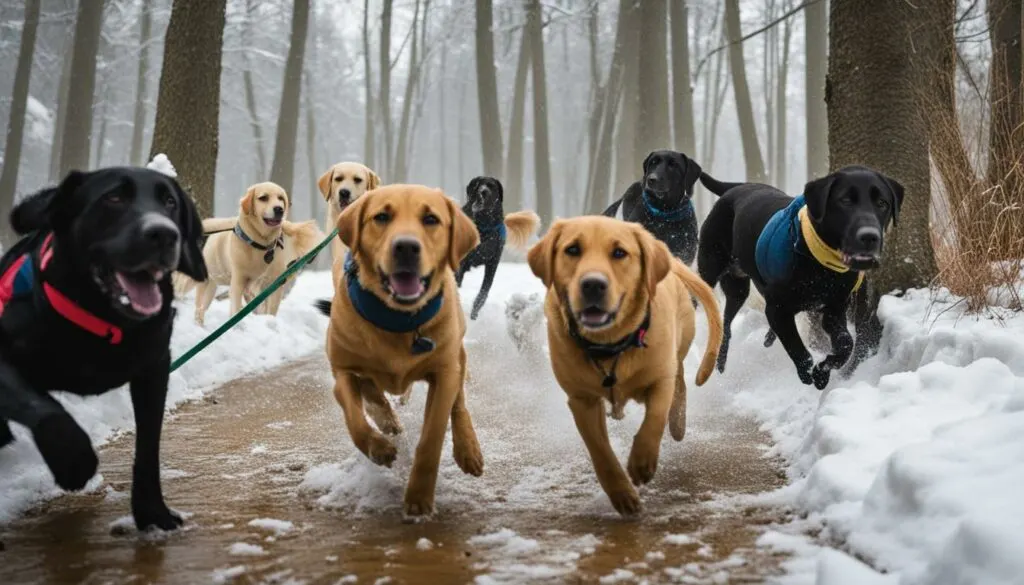
To provide added warmth and protection, consider introducing your labrador to protective gear like booties. While some dogs may resist wearing them at first, patience and positive reinforcement will help them understand that booties can keep their paws warm and shielded from salt and ice. Ensure the booties fit comfortably and securely to avoid any discomfort or blisters.
It’s important to recognize that labradors, like humans, have individual differences in their sensitivity to cold. Some labradors naturally have higher tolerance to chilly temperatures, while others may need more protection and shorter outdoor time. Observe your labrador’s behavior and body language to understand their comfort level in different weather conditions.
Conclusion
Labrador Retrievers are well-suited for cold weather conditions due to their thick double coat and adaptability. However, as responsible owners, it is essential to understand their individual limits and take necessary precautions to ensure their health and comfort.
Providing a suitable shelter is crucial for their well-being during cold weather. An insulated dog house that protects from wind and moisture can offer them a warm and safe space. Additionally, investing in winter gear such as water-repelling coats and booties can provide extra protection and keep them comfortable during outdoor activities.
Grooming plays a vital role in maintaining their coat’s effectiveness in providing insulation and protection. Regular brushing helps remove dead hair and evenly distribute natural oils. While limiting baths can prevent their skin from drying out.
Lastly, monitoring their behavior and watching for signs of cold stress is essential. Labradors may exhibit signs such as shivering, lifting paws, or changes in body language when they are feeling cold. By staying attentive to their needs and promptly addressing any discomfort, we can ensure a safe and enjoyable winter for our beloved Labrador Retrievers.
FAQ
What is the safe temperature for dogs in cold weather?
The safe temperature for dogs can vary depending on factors such as breed, size, weight, age, health, and coat. A general guideline is to start monitoring their comfort levels below 45°F and limit outdoor time for small breeds, thin-coated dogs, older dogs, or those with health issues below 32°F. Below 20°F, there is a risk of hypothermia and frostbite, and close monitoring is crucial.
Are Labradors well-suited for cold weather?
Labradors are generally well-suited for cold weather due to their thick double coat and water-resistant fur. They were originally bred in Newfoundland, where they were used for retrieving fish in icy waters. Their thick double coat and webbed feet make them well-adapted to cold and wet environments.
How can I ensure my Labrador’s comfort when walking them in the cold?
When walking Labradors in the cold, factors such as the type of activity, environmental conditions (wetness, wind), and presence of salt on sidewalks should be considered. Labradors can keep themselves warm through exercise, but precautions should be taken in temperatures below 20°F. Protective gear like water-repelling coats and booties can also provide added warmth and comfort.
What are the signs of cold in dogs?
Signs of cold in dogs can include shivering, lifting paws, trembling, and changes in body language. If your Labrador exhibits any of these signs, it’s a good indicator that they need to warm up and come indoors. Prompt attention to their comfort is essential to prevent any risk of hypothermia.
Can Labradors play in the snow?
Labradors often enjoy playing in the snow, but precautions should be taken to ensure their safety. Wet fur can decrease their ability to insulate body heat, so drying them off after snow activities is important. Watch for signs of discomfort, such as lifting paws or trembling, and provide warm shelter if needed.
What winter gear is recommended for Labradors?
In colder climates, it may be beneficial to invest in winter gear for your Labrador, such as water-repelling coats and booties to protect their paws from salt and ice. Specific recommendations include brands like UpCountry for coats and Pawz for booties. The gear should be properly fitted and introduced gradually to ensure the dog’s comfort.
Are there any health considerations for Labradors in cold weather?
Cold weather can worsen certain health conditions in Labradors, such as joint problems and arthritis. It’s important to provide proper warmth, comfortable bedding, and limit exposure to freezing temperatures. Regular veterinary check-ups are crucial to address any health concerns promptly.
How should I groom my Labrador in winter?
Proper grooming is essential for Labradors in winter. Regular brushing helps remove dead hair and distribute oils throughout the coat. Bathing should be limited to prevent drying out the skin. Careful maintenance of their coat will ensure its effectiveness in providing insulation and protection.
What kind of shelter should Labradors have in cold weather?
Labradors should have access to warm and safe shelter in cold weather. If they spend a lot of time outdoors, an insulated dog house that protects from wind and moisture is recommended. Indoor dogs should have a warm sleeping spot away from drafts to ensure their comfort.
How can I train my Labrador for cold conditions?
Labradors can be trained and acclimated to colder climates by gradually exposing them to cold weather and ensuring positive experiences in the snow. Teaching them to wear protective gear like booties can provide added warmth and protection. Individual differences in sensitivity to cold should be considered when adjusting their routines.
How should I ensure the comfort of my Labrador in cold weather?
Labrador Retrievers are generally well-equipped to handle cold weather due to their coat and adaptability. However, it’s important for owners to understand their individual limits and take necessary precautions to ensure their health and comfort. By providing proper shelter, winter gear, grooming, and monitoring their behavior, Labrador owners can ensure a safe and enjoyable winter for their beloved pets.
